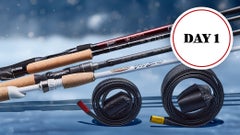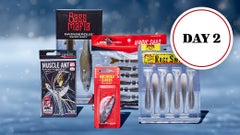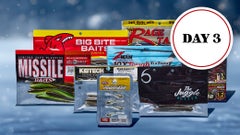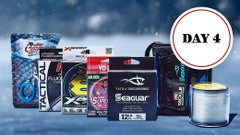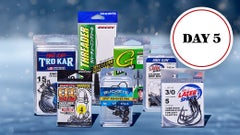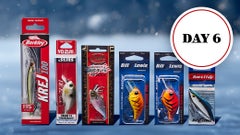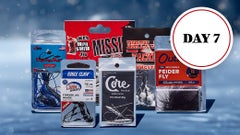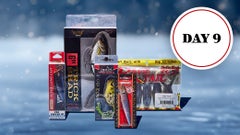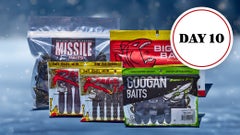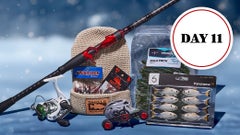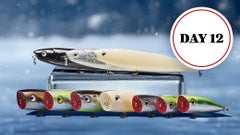BASS Mississippi River Baits, Gear & Patterns
Tommy Biffle Wins BASS Mississippi River
When it was over, his 64-02 total for 4 days bested runner-up Aaron Martens by a little more than 2 pounds. It was his first Elite win since 2010, when he prevailed on his home water (Fort Gibson Lake). Biffle is no smallmouth guru and he had zero intention of pursuing brown fish when practice got under way. He was determined to stay in Pool 8 (site of the launch) after a multiple-pool approach had produced a dismal 96th-place finish a year earlier. His focus this time was entirely on largemouths, which had dominated the 2012 event. "I ran around a bunch in the lower part of the pool and I fished a lot of different stuff - grass, wood where I could find it, current breaks, a little bit of everything," he said. "I hadn't had hardly any bites at all and I was coming back upriver and saw what looked like a willow island. "When I pulled over to it I saw that the willows were too shallow, but as I was going around the end I had a (Gene Larew Biffle Bug) on a flipping stick and I pitched it out on the point and caught a pretty good smallmouth. Then I let the current wash me off the point and I got a Bug on a (Gene Larew) HardHead out, and it was on." He spent the second practice day flipping in and around the Black River, then returned to the island on the last day. "Smallmouth are notorious for leaving and I really thought they'd be gone. I was in that area looking around for something else and I couldn't keep myself from it. I threw one time and a good one got it, and I knew they were still there."
Competition:
After waiting out the procession of south-bound boats on the morning of day 1, Biffle quickly caught a 3-pound smallmouth from the island. He boated several fish thereafter, but all were considerably smaller. "The big ones weren't there," he said. "I ran to my flipping fish and caught a pretty good stringer of them and I ended up weighing four largemouths and the one smallmouth." He moved up from 14th place to 3rd on day 2, and then to 2nd that night when runaway leader Brandon Palaniuk was disqualified due to a violation of one of Minnesota's archaic culling regulations while fishing that state's portion of the river. He reversed his itinerary that day (which started more than an hour and a half late due to thunderstorms that came and went throughout the event) and flipped up a limit before heading to the island. When he finally made his move, he caught a 4-pound smallmouth on a long cast before he even reached his waypoint. He popped another 4 on his third cast and a couple more good ones over the ensuing few minutes before slipping away unseen. "That kind of gave me the idea that it was an afternoon spot," he said. "The only two times I'd fished it in practice were in the afternoon and they were there both times." Day 3 was more of the same - he made only a few casts at the island late in the day and departed with a 4-pounder and a 3 to pull within 7 ounces of Martens, whom he'd trailed by nearly a pound and a half when the day began.
He'd planned to spend all of day 4 at the island, thinking he could catch 18 to 20 pounds if he gave the place a full day's worth of attention, but it didn't work out that way. His notion that it was an afternoon-only locale gained more credence when he had just a single 3-pounder at 9 o'clock (he'd also lost one that size). He caught other fish, but they were miniscule. He'd nearly resigned himself to fishing for 2nd place by the time he went to his flipping fish in pursuit of a 10- to 12-pound bag. He picked up another 3-pounder, but that was it in terms of quality. His second visit to the island produced yet another 3-pounder and a few small specimens. "I had a feeling that the 4-pounders weren't there or I'd have caught one," he said. "I stayed there until there was 45 minutes to go, then I knew I had to try to make something happen. I decided to run down to another island a little farther downstream where I'd caught some off the backside. "The rain (from a powerful storm the night before) had muddied up that water, but there was another place by it where the current was running through some little chutes – I fished it in practice, but I didn't catch anything. My first cast in there I caught a 4, then I pulled back up there with the big motor and made another cast and got a 3-something, almost 4. The next time I pulled up, I let the current push me up against a log. I put the Power-Poles down and went to whacking on them." He caught a half-dozen fish in those closing minutes and made three culls. "I thought I might've had enough (to win), but my initial thought was I had 15 pounds. When I got back and found out I was over 16, I knew I was in good shape. That meant Aaron needed more than 16, too."
Winning Pattern:
Biffle's primary island area had a relatively featureless sandy bottom, but a small ditch was formed where the current made a turn. "I'd get on the downstream side and throw upstream, and then bring the Bug down with the current and let it fall over that ditch. That was really the only thing in there for them to be on." For flipping, he began the event using a smoke silver Bug, but switched to green-pumpkin with some orange dye after he and fellow competitor James Elam both found crawdads of that color in their livewells. "I flipped one of those into a bush right beside the boat right after I'd just flipped the silver one in there, and as soon as I did it, one bit it. From then on I only fished that color and just caught the heck out of them. On day 3 I caught between 55 and 65 fish, so it was definitely a color they wanted."
Winning Gear:
HardHead gear: 7'6" heavy-action Quantum EXO flipping stick, Quantum EXO PT 300 casting reel (7.3:1 ratio), 20-pound Sunline Shooter fluorocarbon line, 7/16-ounce Gene Larew HardHead, Gene Larew Biffle Bug (green-pumpkin). "That rod isn't as stiff as my signature series flipping stick and I teased (Quantum) when they made it and told them I could use it for crankbaits," he said. "I like my 6'10" rod for the Bug most of the time because it's stiff, but I've used that longer one in the current a couple of times now and I can get a longer swing with it. Those fish were picking the bait up and swimming toward me, and I'd jerk with the rod and run backward almost to make sure I got them."
Flipping gear: 7'6" extra-heavy Quantum Tour Elite Tommy Biffle flipping stick, same reel, 25-pound Sunline Shooter fluorocarbon, 5/16-ounce Elite Tungsten weight, 4/0 Paycheck Baits Punch Hook, Gene Larew Biffle Bug (smoke silver or green-pumpkin).
Main factor: "The biggest thing was not letting anybody see me on that spot."
Performance edge: "I'd say the Bug and the HardHead - having the right bait and the right color."
Mississippi River Elite Series Winning Pattern Bassfan 6/25/13 (John Johnson)
Aaron Martens' Pattern, Baits & Gear
Dropshot gear: 6'11" medium-heavy Megabass Orochi XX Aaron Martens Signature Series Dropshot rod, Shimano Stella 2500 spinning reel, 7- or 8-pound Sunline Shooter fluorocarbon line, 3/16- or 1/4-ounce dropshot weight, 3/0 or 4/0 Roboworm Rebarb or size 1 Gamakatsu dropshot hook, 4 1/2" or 6" Fat Roboworm or 6" original Roboworm (Aaron's magic). He used the size 1 hooks and the original Roboworm when he resorted to a wacky rig during slow-bite periods.
Jig gear: 7'2" medium-heavy Megagass Orochi XX Perfect Pitch rod, Shimano Metanium casting reel (7.1:1 ratio), 16-pound Sunline Shooter fluorocarbon, 3/4-ounce Davis jig (green-pumpkin), Zoom twin-tail trailer (green-pumpkin).
Main factor: "I made a lot of moves and fished a lot of different spots."
Performance edge: "The whole boat package with the Power-Poles, the graph and everything. The graph was really important because I was constantly moving and looking for fish."
Mississippi River 2-5 Patterns Bassfan 6/26/13 (John Johnson)
John Crew's Pattern, Baits & Gear
Flipping gear: 7'6" heavy-action Pinnacle Perfecta flipping stick, Pinnacle Optimus LTE casting reel (7.3:1 ratio), 20-pound Vicious fluorocarbon line, 5/16-ounce tungsten weight, 5/0 Gamakatsu Heavy Cover Worm hook, Missile Baits D-Bomb (superbug).
Frog gear: 7' heavy-action Pinnacle Perfecta rod, same reel, 65-pound Vicious braided line, Spro Bronzeye Frog 65 (black or killer gill).
Main factor: "I practiced in a lot of different areas - I really plowed through a lot of stuff in my Bass Cat/Mercury - and that definitely paid off."
Performance edge: "That 7-foot rod puts very little fatigue on your arm and wrist when you're working the frog. And when one bites, it's got the backbone to let you crack on them."
Mississippi River 2-5 Patterns Bassfan 6/26/13 (John Johnson)
Fred Roumbanis' Pattern, Baits & Gear
Topwater gear: 7'5" heavy-action iRod Air rod, Ardent Elite casting reel (7.2:1 ratio), 50-pound P-Line braided line, various hollow topwater baits. His bait offerings included a couple of versions of the Snag Proof Bobby's Perfect Frog (including one with a buzzbait-style blade and paddle legs), an Optimum Baits Furbit, a Picasso Shad Walker and a Spro Bronzeye Frog 65.
Main factor: - "If I was going to get beat, it was going to be with me playing my own game, which is frogging. Some of the guys who really caught them mixed it up and my hat's off to them."
Performance edge: - "I can make really long casts with that iRod and I can get really good hooksets. It also allowed me to get the best action out of each bait."
Mississippi River 2-5 Patterns Bassfan 6/26/13 (John Johnson)
Brandon Card's Pattern, Baits & Gear
Frog gear: 7'9" heavy-action Pinnacle Perfecta rod, Pinnacle Optimus LTE casting reel (7.3:1 ratio) 65-pound Spiderwire Ultracast Ultimate Braid line, unnamed frog (white or natural).
Swim-jig gear: 7'6" medium-heavy Pinnacle Perfecta rod, same reel, 17-pound Berkley Trilene 100% fluorocarbon line, 3/8-ounce Lethal Weapon jig (bluegill), Reaction Innovations Skinny Dipper trailer (low blow).
Flipping gear: Same rod and reel as frog, 25-pound Berkley Trilene 100% fluorocarbon, 1/2-ounce Mission jig (black/blue), Zoom Big Salty Chunk trailer (green-pumpkin).
Main factor: "Patience - I stayed in an area where I knew there were fish. Thankfully I had my best stretch all to myself."
Performance edge: "My Suzuki outboard is really reliable. Most other engines I've had suck up grass in conditions like that and they overheat and then you can't idle the flats like you want to. I could idle anywhere I wanted to go."
Mississippi River 2-5 Patterns Bassfan 6/26/13 (John Johnson)















